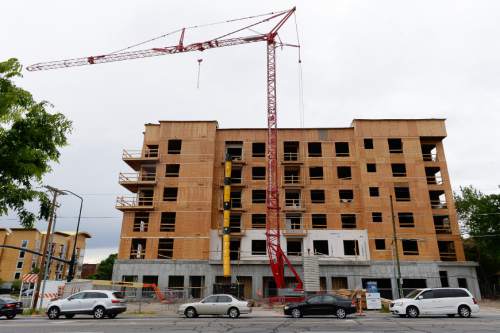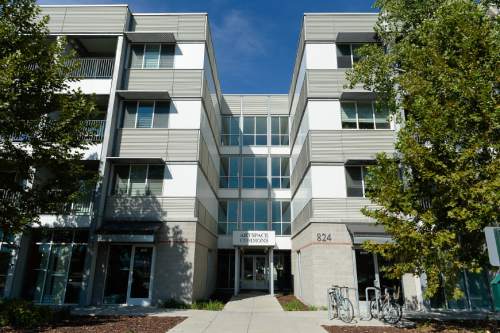This is an archived article that was published on sltrib.com in 2015, and information in the article may be outdated. It is provided only for personal research purposes and may not be reprinted.
Nearly half of Salt Lake City's renters are shouldering rents beyond their budgets, leaving them pinched for cash when it comes to other living needs, a new study says.
An analysis released Wednesday finds that about 25.6 percent of the Utah capital's tenants fork over between 30 cents and 50 cents of every dollar they earn on monthly rent, making them "moderately cost-burdened."
And another 23.1 percent are "severely cost-burdened," meaning they spend more than half their earnings to rent apartments or houses, according to the study by the online listing service ApartmentList.
The study, based on 2014 U.S. census data on median rents and incomes, was released just as both candidates in the hotly contested Salt Lake City mayor's race are making affordable housing a central campaign issue.
Finance experts say rents above 30 percent of residents' incomes force difficult day-to-day sacrifices, with burdened renters having to forgo other basics such as health care or saving for emergencies, retirement or a mortgage down payment.
One Utah housing advocate described these renters as living on the edge of homelessness or financial disaster.
"Once there's a hiccup in their lives, they can't catch up," said Tara Rollins, executive director of the nonprofit Utah Housing Coalition, which lobbies for affordable-housing construction statewide.
"They give up medications and get sick," Rollins said. "Or they can't get to work because their car got towed or they can't afford the gas."
Salt Lake City is hardly alone in this regard.
The ranks of cost-burdened renters nationwide have grown by nearly 1.7 million people since the onset of the Great Recession, according to the ApartmentList study.
Regionally, the study pegged the share of cost-burdened renters at 39.6 percent to 51 percent of all renters for Wasatch Front counties, with Salt Lake County at 46.5 percent.
Ogden's cost-burdened ratio was 56.5 percent and West Valley City's 51.1 percent. Provo and Orem had ratios of 54.1 percent and 45.5 percent, respectively.
The new research comes out as Salt Lake City emerges as part of a regional boom in apartment construction, with thousands of new units planned or already being built. Most of the new dwellings along the Wasatch Front, however, continue to be priced at higher market rates.
A 2013 study had estimated the city needed an additional 8,240 moderately priced homes to meet the needs of low- and medium-income workers and their families, the disabled and those on fixed incomes.
In late January, Mayor Ralph Becker unveiled an initiative meant to bring at least 5,000 additional affordable apartments and single-family homes into the city's housing stock during the next five years, a program dubbed "5000 Doors." Nearly a year in the works before it was announced, the effort has involved private developers, lending institutions, government agencies, community groups and homeless advocates, said Melissa Jensen, the city's deputy director of Housing and Neighborhood Development.
The city also has been a conduit for nearly $4.3 million in state tax incentives, federal block grants, loans and other funding sources to make it feasible for developers to build affordable multi- and single- family dwellings, whether stand-alone or as part of larger market-rate housing projects.
"It's been the heart of what we do," said Jensen, who called 5000 Doors "a collaborative effort that requires a diverse set of partners to truly be successful."
Becker, whose professional background includes urban planning, repeatedly has mentioned the importance of ensuring that residents from a variety of income levels are able to live affordably in the city.
At a news conference this week, the mayor offered a first-year tally on the progress of 5000 Doors thus far: 797 affordable units built and 1,300 more in the development process.
"The 5000 Doors Initiative has achieved excellent successes in its first year," Becker said in a statement. "I'm very happy to see the spectrum of residential options continuing to grow in our community."
His administration has also made several high-profile pieces of city-owned property available for residential redevelopment, including the former Public Safety Building at 315 E. 200 South.
Becker is running for a third term against challenger Jackie Biskupski. Election Day is Tuesday.
In stump speeches, Biskupski has said a range of people are forced to steer clear or move out of Salt Lake City by high rents, including college graduates, newlyweds, senior citizens and middle-income workers who find the city's cost of living too high.
Biskupski calls Becker's 5000 Doors effort "too little, too late."
"We currently have an affordable-housing shortage of over 8,000 units," she said, "and the 5000 Doors initiative creates only a few hundred new units."
If she wins, Biskupski vows to create a special commission to produce viable plans within 100 days of how the public and private sectors can spur new moderately priced housing construction across the city.
Such a plan, she said, would involve new zoning, tax incentives and allowances for tiny houses along with additional accessory dwelling units, also known as mother-in law apartments built in existing homes.
Biskupski spokeswoman Maryann Martindale said affordable housing has loomed large among issues mentioned by residents on the campaign trail.
"People are frustrated," Martindale said. "You have your big issues, like education and air quality, but then you have the real things like this that impact everyday, working-class residents. And we're just not making enough headway."
tsemerad@sltrib.com Twitter: @TonySemerad









